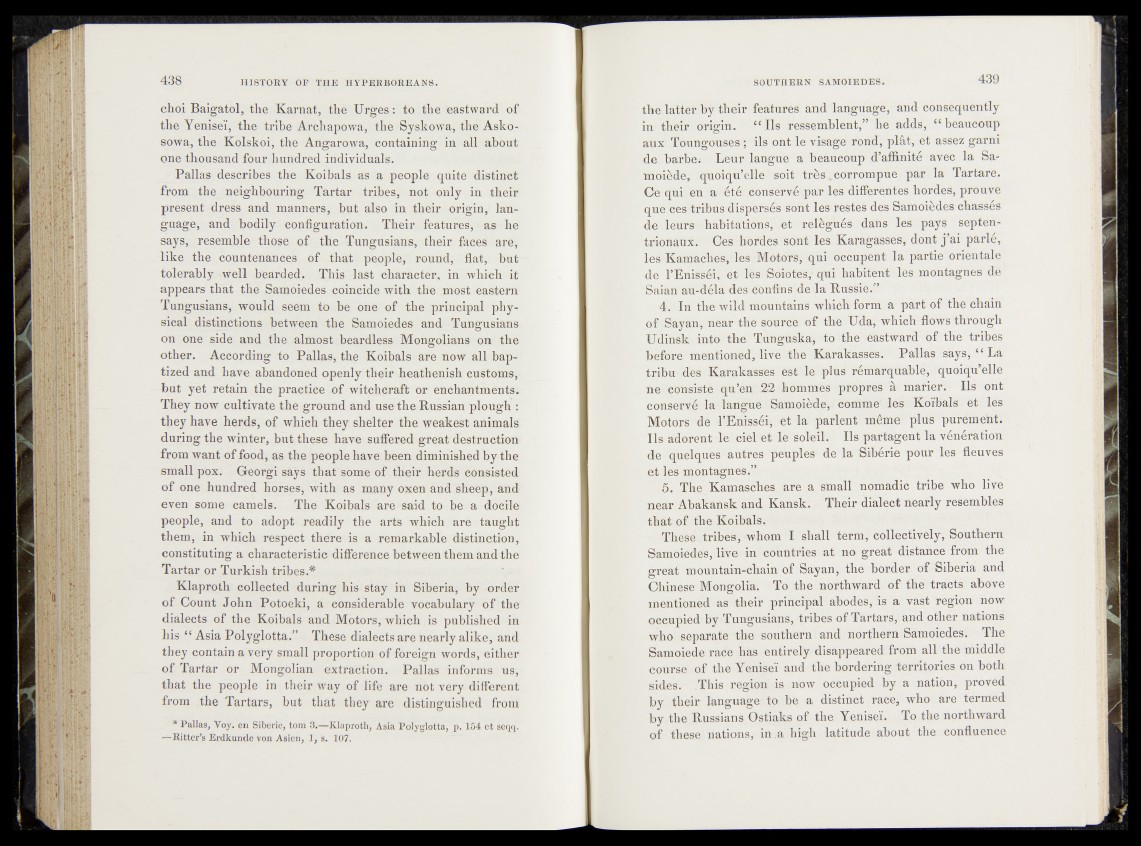
choi Baigatol, the Karnat, the Urges: to. the «eastward of;
the Yenisei', the tribe A'rchapowa, the Syskowa, the Asko-
sowa, the Kolskoi, the Angarowa, containing in all about
one thousand four hundred individuals.
Pallas describes the Koibals as a people quite distinct
from the neighbouring Tartar tribes, not only in their
present dress and manners, but also in their origin, language,
and bodily configuration. Their features^ as he
says, resemble those of the Tungusians, their faces are,
bike the countenances of that people, round|iRflat, but
tolerably -well bearded. This last character, in which it
appears that the Samoiedes coincide with the most eastern
Tungusians, would seem to be one of the principal physical
distinctions between the Samoiedes and Tungusians
on one side and the almost beardless Mongolians Urn the
other. According to Pallas, the Koibals are now all baptized
and have abandoned openly their heathenish customs,
but yet retain the practice of witchcraft or enchantment's.
They now cultivate the ground and use the Russian plough :
they have herds, of which they shelter the weakest animals
during the winter, but these have suffered great destruction-
from want of food, as the people have been diminished by the
small pox. Georgi says that some of.their' herds consisted;
of one hundred horses, with as many oxen and’sKeep, and?
even some camels. The Koibals are -said to- be a docile
people, and to adopt readily the arts which are- taught
them, in which respect there is a remarkable distinction,
constituting a characteristic difference between them and the
Tartar or Turkish tribes.*
Klaproth collected during his stay in Siberia, by order
of Count John Potoeki, a considerable vocabulary of the
dialects of the Koibals and Motors, which is published in
his: ‘‘ Asia Polyglotta.” These dialects are nearly alike, and
they contain a very small proportion of foreign words, either
of Tartar or Mongolian extraction. Pallas informs us,
that the people in their way of life are not very different
from the Tartars, but that they are distinguished from
* Pallas, Voy. en Siberie, tom £ —Klaproth, Asia Polyglotta, p. l54 et seqq.
—Bitter’s Erdkunde von Asien, V} fc. 107.
the latter by their features and language, arid consequently
in their origin. “ Ils ressemblent,” he adds, “ beaucoup
aux Tou-ngouses'‘fail's ont le visage rond, plât, et assez garni
de barbe; Leur langue a beaucoup d’affinité avec la Sain
oiède, quoiqdlèfle soit très „corrompue par la Tartare.
Ce qui en a été coriséWé^par les differentes hordes, prouve
que ces^tribus dispersés‘sont les restés des Sumoièdes chassés
deïtl'èurs habitations, et relégués- dans les pays - septentrionaux.
Ces-hordess*sont les-Karagasses, dont j ’ài parlé,
les Kamaches’, les-Mbtors, qui occupent la partie orientale
de l’Erii^ëîl- et dësr’SOiotés^ qui habitent lfes montagnes dé
wSaiàn‘au-déla dei’ic'onfins-'de *îa Russiëi”t '
4., In the wilffimbuntrilriS1 which form à part of the chain
ofi,.Sayan, -near the-source of fhé'Uda, which flows through
Udirisk into the TungUska, to the eastward of the tribes
before mentioned, liv e ’the Karakasses. J?allas sàys, “ La
"tribu des Karakasses;- è ff le plus rémarquablé, quoiqu’elle
ne consiste qu’ern 22 hommes" propres à marier': Us ont
coriier-vé la langue^amOiede,-.*cOirime'‘ les Korbals et lés
Motdrë dè 'l’Enisséij d t la parlent même plus purement.
Ils adorent de ciel et»lè^Soleil. Us partagent la vénération
& quelques autres peuples de la Sibérie jioiir les fleuves
et les montagnes,’^
Vin The Kamasches are a small nomadic tribe who live
near Abakansk and Kansk, Their dialect nearly resembles
that; of the Koibals. ?
These„?tribes, whom I shall term, collectively, Southern
Samoiedes, live in cdfiritries at no' great distance from thé
great mountain-chain of Sayan, the border 'o# Siberia and
Chinese Mongolia. To the northward of the tracts above
mentioned as their principal abode»,‘fis a vast region now
occupied by Tungusians, tribes of Tartars, and other nations
who separate the southern and northern Samoiedes; The
Samoiede race has entirely disappeared from all the middle
course of the Yenisei and the bordering territories on both
sides. .This region is now occupied by a nation*; proved
by their language' to; be,, a distinct race, who are termed
by the Russians Ostiaks of the Yenisei'. To the northward
of these nations* in a high ' latitude about the confluence